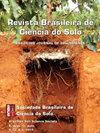苜蓿土壤微生物根际群落对氯脲-乙基除草剂的响应
IF 2
4区 农林科学
Q3 SOIL SCIENCE
引用次数: 1
摘要
采用Biolog Eco技术,研究了播后苗前和苗后(茎叶喷施)不同化学除草剂施用方式对苜蓿根际土壤微生物群落碳源利用特征的影响。苗期后喷施除草剂的茎叶well color developmental (AWCD)平均值和微生物代谢多样性指数显著低于苗期前和未喷施除草剂的平均值。此外,播后苗期除草剂处理对土壤微生物没有影响。主成分分析(PCA)表明,不同除草剂处理间根际土壤微生物群落多样性差异显著。碳源类型对除草剂处理变化最敏感的是碳水化合物,其次是氨基酸和羧酸。除草剂施用方式显著降低了微生物群落利用碳源的能力,主要表现在利用聚合物的能力上。综合分析苜蓿的生长和根系生理生化指标表明,施用除草剂氯脲乙基降低了苜蓿的产量,两种不同的施用方式无显著差异。施用除草剂及不同施用方式对苜蓿根系活性和膜通透性均有显著影响,表明施用除草剂破坏了苜蓿根系的膜通透性和活性。茎叶出苗后土壤除草剂残留对苜蓿生长和土壤微生物的影响不容忽视。本文章由计算机程序翻译,如有差异,请以英文原文为准。
Microbial rhizosphere communities in response to chlorimuron-ethyl herbicide in soils under alfafa crop
: Biolog Eco technology was used to investigate the effects of different chemical herbicide application methods, such as pre-emergence after sowing and post-emergence (stem and leaf spraying), on the characteristics of carbon source utilization by microbial communities in alfalfa rhizosphere soil. The averages of well color development (AWCD) and microbial metabolism diversity indices of post-emergence herbicide spraying on stems and leaves were significantly lower than those of pre-emergence herbicide and without herbicide treatments. Furthermore, pre-emergence after sowing herbicide treatment did not affect soil microorganisms. The principal component analysis (PCA) revealed that the microbial community diversities of the rhizosphere soils differed significantly between herbicide treatments. Carbohydrate was the carbon source type that was most sensitive to herbicide treatment changes, followed by amino acids and carboxylic acids. The herbicide application method significantly reduced the capacities of the microbial community to utilize the carbon sources, as mainly manifested in the ability to use polymers. As shown by a comprehensive analysis on the growth of alfalfa and the physiological and biochemical indices of its root system, the application of herbicide chlorimuron-ethyl reduced the alfalfa yield, and the two different application methods tested showed no significant difference. Herbicide application and different application methods showed significant impacts on alfalfa root activity and membrane permeability, suggesting that the application of herbicide damaged the membrane permeability and the activity of the alfalfa root system. Impacts of herbicide residues in the soil after stem and leaf post-emergence treatment on alfalfa growth and soil microorganisms should not be ignored.
求助全文
通过发布文献求助,成功后即可免费获取论文全文。
去求助
来源期刊

Revista Brasileira De Ciencia Do Solo
农林科学-土壤科学
CiteScore
3.00
自引率
11.80%
发文量
32
审稿时长
9-24 weeks
期刊介绍:
The Revista Brasileira de Ciência do Solo is a scientific journal published by the Brazilian Society for Soil Science (SBCS), founded in 1947, and is responsible for the propagation of original and inedited technical-scientific work of interest for Soil Science.
Contributions must not have been previously published or submit to other periodicals, with the only exception of articles presented in summarized form at professional meetings. Literature reviews are accepted when solicited by the Editorial Board.
 求助内容:
求助内容: 应助结果提醒方式:
应助结果提醒方式:


